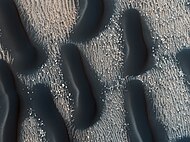Proctor (Martian crater) – Wikipedia
From Wikipedia, the free encyclopedia
Crater on Mars
Proctor is a large crater in the Noachis quadrangle of Mars. It measures 168.2 kilometres (104.5 miles) in diameter and was named after Richard A. Proctor, a British astronomer (1837–1888).[1]
Dune fields[edit]
The crater contains a 35 x 65 km dark dune field.[2][3] It was one of the first sand dune fields ever recognized on Mars based on Mariner 9 images.[4] The crater’s dunes are being monitored by HiRISE to identify changes over time.[5]
-

Topographical map showing location of Proctor crater and other nearby craters
-

Another Viking image of the dunes in Proctor and in nearby craters
-

The edge of a dark dune field on the floor of Proctor crater
-

Close-up of dunes on floor of Proctor crater, as seen by CTX camera on Mars Reconnaissance Orbiter. This is an enlargement of part of previous image.
See also[edit]
References[edit]
- ^
“Gazetteer of Planetary Nomenclature | Proctor”. usgs.gov. International Astronomical Union. Retrieved 4 March 2015.
- ^ Fenton, L. K. (2005). “Seasonal Movement of Material on Dunes in Proctor Crater, Mars: Possible Present-Day Sand Saltation” (PDF). Lunar and Planetary Science XXXVI (2005).
- ^ Mary Chapman, ed. (2007). The Geology of Mars: Evidence from Earth-Based Analogs. Cambridge University Press. p. 250. ISBN 978-0-521-83292-2.
- ^ “Dune Activity in Proctor Crater”. Mars Global Surveyor – Mars Orbiter Camera – MGS MOC Release No. MOC2-170. Malin Space Science Systems. 10 August 1999.
- ^ Bridges, Nathan (9 March 2009). “Sand Dunes and Ripples in Proctor Crater”. HiRISE Operations Center.
External links[edit]
Recent Comments